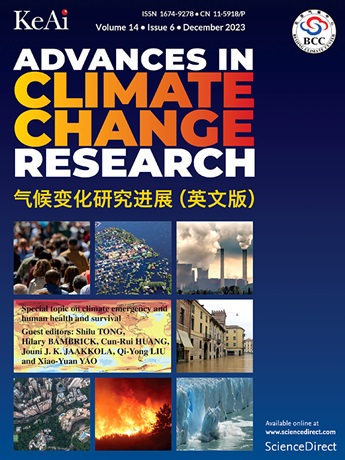Timber and carbon sequestration potential of Chinese forests under different forest management scenarios
IF 5.2
1区 地球科学
Q1 ENVIRONMENTAL SCIENCES
引用次数: 0
Abstract
Developing forestry action plans with the goal of carbon neutrality is a critical task to identify carbon sink potential and balance the pathways of China's forests. Current research that predicts forest biomass carbon stock and sink potential has shortcomings, such as an incomplete assessment of China's forest carbon sink range, assumptions based on unchanged forest area in the base year and insufficient consideration of natural and human disturbance factors. This study utilised the national forest inventory (NFI) data to construct a model of forest growth and consumption using a machine learning algorithm (i.e. random forest), identified suitable areas for future forest expansion by integrating multi-source data, and set up three future forest management scenarios: business as usual (BAU), enhanced policy scenario (EPS) and maximum potential scenario (MPS). In addition, changes in the area, volume stock and biomass carbon stock in China's forests between 2020 and 2060 were predicted under three forestry activities (i.e. existing forest, afforested/reforested (AR) forest and forest conversion) and three climate scenarios (i.e. SSP126, SSP370 and SSP585) based on the 9th NFI (2014–2018). According to China's relevant planning goals and suitable forest space, the area of AR forests is predicted to be 55.55 × 106 hm2 by 2060, and the forest coverage rate is predicted to increase from 23% in 2018 to 28% by 2060. Biomass carbon sequestration (BCS) between 2020 and 2060 in AR forests is predicted to be 36.00 TgC per year. By 2060, the average BCS is predicted to be approximately 140.00–287.56 TgC per year in China's forests, which is mainly owing to arbor forest management. Under the BAU and EPS scenarios, BCS in China's forests is expected to decline from 2020 to 2060. However, under the MPS, BCS in China's forests is projected to increase and be maintained at 322 TgC per year or above by 2060, with wood production reaching 4.71 × 108 m3 per year. China's forests are predicted to experience an increase in biomass carbon stock in the future and play a role as a carbon sink. By taking measures to achieve the maximum growth potential of all forest types, China's forests will achieve a win‒win situation between carbon sinks and timber production.
不同森林经营模式下中国森林的木材和固碳潜力
制定以碳中和为目标的林业行动计划是确定中国森林碳汇潜力和平衡路径的关键任务。目前预测森林生物量碳储量和碳汇潜力的研究存在不足,如对中国森林碳汇范围的评估不完整、基于基准年森林面积不变的假设、对自然和人为干扰因素考虑不足等。本研究利用国家森林资源调查(NFI)数据,利用机器学习算法(即随机森林)构建了森林生长和消费模型,通过整合多源数据确定了未来森林扩张的适宜区域,并建立了三种未来森林经营情景:照常经营(BAU)、增强政策情景(EPS)和最大潜力情景(MPS)。此外,基于第9次NFI(2014-2018),预测了2020 - 2060年中国森林面积、蓄积量和生物量碳储量在3种林业活动(现有森林、造林/再造林(AR)林和森林转换)和3种气候情景(SSP126、SSP370和SSP585)下的变化。根据中国相关规划目标和适宜的森林空间,预计到2060年,AR森林面积为55.55 × 106 hm2,森林覆盖率将从2018年的23%提高到2060年的28%。预计2020年至2060年AR森林的生物质固碳量(BCS)为每年36.00亿吨碳当量。预计到2060年,中国森林的平均BCS约为1400 - 287.56 TgC /年,这主要是由于乔木林的经营。在BAU和EPS情景下,预计2020 - 2060年中国森林BCS呈下降趋势。然而,在MPS下,到2060年,中国森林BCS预计将增加并保持在322亿吨/年以上,木材产量将达到4.71 × 108立方米/年。预计未来中国森林的生物量碳储量将增加,并发挥碳汇的作用。通过采取措施,最大限度地发挥各类森林的生长潜力,中国的森林将实现碳汇和木材生产的双赢。
本文章由计算机程序翻译,如有差异,请以英文原文为准。
求助全文
约1分钟内获得全文
求助全文
来源期刊

Advances in Climate Change Research
Earth and Planetary Sciences-Atmospheric Science
CiteScore
9.80
自引率
4.10%
发文量
424
审稿时长
107 days
期刊介绍:
Advances in Climate Change Research publishes scientific research and analyses on climate change and the interactions of climate change with society. This journal encompasses basic science and economic, social, and policy research, including studies on mitigation and adaptation to climate change.
Advances in Climate Change Research attempts to promote research in climate change and provide an impetus for the application of research achievements in numerous aspects, such as socioeconomic sustainable development, responses to the adaptation and mitigation of climate change, diplomatic negotiations of climate and environment policies, and the protection and exploitation of natural resources.
 求助内容:
求助内容: 应助结果提醒方式:
应助结果提醒方式:


